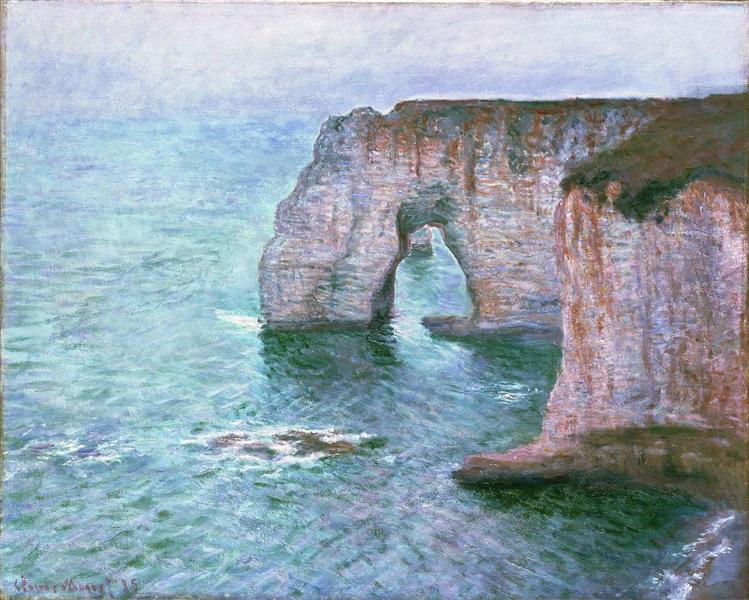Description
In the painting "Manneport seen from the east" of Claude Monet, created in 1885, the fundamental principles of impressionism are manifested, an artistic movement that seeks to capture the ephemeral light and atmosphere of a place in a specific moment. This work, which offers a view of the famous natural stone arch on the Norman coast, stands out not only for its landscape theme, but also for its technique, which encapsulates the essence of modernity in the painting of the nineteenth century.
Monet, a pioneer of impressionism, moves away from traditionally detailed compositions and idealized representations, opting for a style that is based on the direct observation of nature. In this work, you can see a rich and nuanced palette that uses tones of blue, gray and green, which allow the transposition of light and the characteristic atmosphere of the coastal area. The mixture of these colors results in a vibrant and dynamic surface, where the light seems to dance on water and rocks.
The composition of "Manneport seen from the east" is structured through a skillful use of diagonal lines and organic forms. The masses of the rocks and the arch are drawn with loose and fast brushstrokes, while the sea, which extends to the bottom, shows an almost liquid quality. The arrangement of the elements on the canvas guides the viewer's look from the forefront, where the rocks and the calm sea are located, through the arch and towards the distance, where the landscape vanished in an indeterminate horizon.
It is important to point out the almost absence of human figures in this work. Unlike other monet compositions in which the human figure can play a central role, here the approach focuses on the majesty of nature. The absence of characters causes a reflection on the relationship of the human being with the natural environment, emphasizing the greatness of the landscape rather than the presence of man. This choice is intentional, highlighting the immensity of nature that is often relegated in modern life.
The work also communicates a sense of immediacy and experience. Monet, known for its "loose brushstroke" technique, uses paint touches that suggest movement and change, capturing light and color so that they seem fresh and snapshot. This ephemeral element reflects an observation philosophy in which the world is presented in its purest state, without ornaments or complex interpretations.
The historical context in which Monet paints this work is relevant to understand its significance. During the 80s of the nineteenth century, Monet was already a consecrated artist and his technique had evolved as he was looking for new ways to interpret light and color. Monet's series of works on the Normandy coast is a manifestation of its desire to capture the changing essence of the coastal environment and the temporal experience of the landscape.
"Manneport seen from the east" is, therefore, a work that encapsulates not only Monet's technical mastery, but also a time when the artist's role is redefined. By dispensing with human figures and focusing on the sublime representation of nature, Monet offers a vision that invites contemplation and astonishment. This painting It becomes a window to beautifully balanced serenity and violence of natural landscapes, a testimony of art ability to capture the ephemeral and the significant in a single moment.
KUADROS ©, a famous paint on your wall.
Hand-made oil painting reproductions, with the quality of professional artists and the distinctive seal of KUADROS ©.
Reproduction service paintings With a guarantee of satisfaction. If you are not completely satisfied with the replica of your painting, we refund your money 100%.

